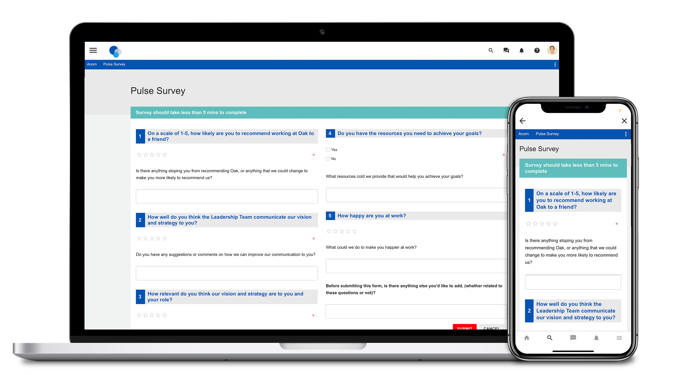Internal communication can be tricky for any business to master. What is clear, however, is that how a worker feels about their employer will at least partly be down to how their organisation engages with them. Oak's State of IC report found that 37% of internal communicators believe their top blocker is lack of awareness about the value of internal comms at an executive level. It's time for internal communications to have their seat at the table.
This guide will take you through what internal communications is, how it has evolved over time, real-life examples and best practices that can be implemented into an internal communications plan. This comprehensive guide will include:
- Internal Communication Definition
- Why is Internal Communication Important?
- Types of Internal Communication
- Internal Communications Stats
- How to Improve Internal Communication
- Internal Communication Tools
Internal Communication Definition
Whilst there are many different definitions of internal communication, Internal communication is the overall way that a company communicates with it's employees.
Russell Grossman, Government Communication Service Head of Profession for Internal Communications defines it as a function that exists: ‘to help leaders inform and engage employees, in a way which motivates staff to maximise their performance and deliver the business strategy most effectively.”
Internal communications is integral to the relationship between a company and its employees, keeping them connected and informed. To ensure effective communication internally, a business must be equipped with the appropriate information and tools.
History of Internal Communications in the Workplace
- 1920’s- Researchers found that to optimise employee output, they must be made to feel emotionally connected to their work and workplace
- 1930’s- With the commercialisation and revolution of business communication,
businesses started to adopt internal comms strategies. - 1960’s- Internal communications theory established with publication of Douglas McGregor’s
Human Side of Enterprise - 1990’s-Term ‘engaged employee’ is coined- communication starts to take a ‘trickle down’ form starting with leadership
- 2000’s- Rise of the internet sees business become more transparent to its workers
- 2010’s- Employee engagement becomes the businesses’ shop window and high on the agenda of businesses and workers alike
Why is Internal Communication Important?
Internal communications is integral to ensuring an alignment of employees and the organisation’s goals. Good internal communication facilitates collaboration across departments and within, as well helping to cultivate business culture.
An internal function that engages with all its workforce effectively is far more likely to get the best out of them by connecting through appropriate channels.
Companies who embrace technology tend to fare better with internal communication. Modern intranet solutions with chat functions, community hubs and news feeds that share company information, aids connectivity.
Recommended Reading 📖: Why is Internal Communication Important?
Types of Internal Communication
1. Management
Management and leadership communication internally is generally around strategy, results and company updates. Gallup found that leaders account for 70% of the variance in employee engagement, having a huge impact on culture and how people interact with one another. Leaders can help employees to feel more connected with the business, taking more pride in their own work as a result.
2. Peer-to-Peer sharing
Peer-to-peer sharing relates to communication between colleagues. When employees engage with one another they can share information and utilise knowledge to carry out their duty more effectively. They can also support each other emotionally and professionally. In a world of remote work, central chat functions can be a simple way of ensuring these lines of communication are open.
3. Team collaboration
Team collaboration is an activity between colleagues working on the same project or to achieve the same goal. Collaboration is so important to the delivery of work. It is impossible to have standard processes, shared ideas or agreed deliverables and so much more without it. The workforce tend to agree, with 75% believing teamwork is important. To have the best chance of success a team needs to be set up with the tools to collaborate.

4. Informal
Informal is a straightforward but very important type of internal communication. Gallup found that employees who have a best friend at work are 7x more likely to be engaged at work. Working remotely has made this more of a challenge, especially when onboarding new employees. Having online social hubs where employees can discuss mutual interests can help to build these relationships in the modern workspace.
5. Resources
Internal communication isn’t just facilitated by dialogue, but also access to information. Did you know employees spend 3.6 hours each day trying to find information? Central knowledge bases are key to employees possessing the important knowledge and a vital facet to internal communication.
How to Improve Internal Communication
There are a myriad of hurdles that businesses face when it comes to internal communications. However, there are ways to improve internal communication that are fairly straightforward and can help you implement an effective internal communications plan.
Assess current internal communications
To make necessary changes to your internal communications plan you first need to understand what you do well and what you don’t. This can be done by doing an audit or assessment of the current situation. Measurements for current engagement and an audit of your communication tools/strategy will help understand the current landscape.
Lead by example
An ‘open door’ type of approach will help senior figures seem more approachable and sets an example of open communication from the top. This will reverberate around the business. Not only does it make employees feel more comfortable with their managers but also brings issues to the fore much quicker with added transparency.
What type of leader are you? Take our quiz and discover the skills of successful leaders in this blog.
Ask your employees
Employees should be centric to your internal communications strategy, so ask for their opinion around current workplace communication. Feedback won’t be uniformed, but it will give you a better understanding of how the businesses current internal communication is actually received and what their needs are. Discover how they feel through focus groups, one to ones and using pulse surveys and polls.
Use internal communication channels
It's not just what you say, it's how you say it. Implement communication channels that engage all of your workforce to encourage a more collaborative environment. As there are so many options, intranet news feed updates, company email, mobile applications and more, it is very important to choose the channels most suitable for your workforce. Need help with getting your messaging right on each channel? Curated content can solve that...
Recommended Reading 📖: Too Many Internal Comms Channels? Read This
Recognising your employees
Recognising your employees for their achievements and facilitating peer-to-peer recognition is incredibly effective, yet very simple. This can be done by introducing incentives or even just a ‘well done’ over the company chat function. A positive culture can be cultivated in this way, where employees feel that their work is valued.
Internal Communication Tools
Here are some of the internal communication tools of a modern day intranet that can help you realise your internal communications plan:
- Analytics
- Autio Translations
- Conversation Management
- Newsletters
- Company Branding
- Homepages
- Extranet
- Content Management
- Hubs & Communities
- Mobile App
- Social Intranet
- Pulse Survey & Polls
- Curated Content
Recommended Reading 📖 Internal Communication Tools
With such an extensive range of features, your intranet can be the one stop shop for all your communications. Havebury Housing found this to be the case for them. Here's what their Comms Manager, Hayley Lambert said about us...
“The Hive gives us a one-stop shop for all of our comms. Before it was erratic and we were firefighting a lot of the time. It’s helped us to be more strategic in our comms because we have that tool that does everything.”
How to Develop an Internal Communications Strategy
Employee productivity increases by 20 to 25% in organisations where employees are connectedAn internal communication strategy is key to communicating effectively with everyone across the business. Having a clear strategy is the essential blueprint for your success and connecting people in your organisation.
In developing your internal communications strategy there are first five key questions to consider. These are questions so simple that are asked in most situations, but also give clear answers.
Why?
Defining objective(s) and why you want to achieve this. This will help you devise whether this will add value to your business.
Who?
Who is it you have to communicate with? This should make it simpler to define which channels you should use
What?
What is it you want your employees to engage with and what is it you have to do to engage with them?
When?
When is it the right time to be implementing a new intranet or adopting an important new strategy? Is there anything ongoing with the business that could conflict?
How?
How should your message be transmitted? This is important when choosing which channels and content will be central to your strategy
Recommended Reading 📖: How to Improve Internal Communications
Top 5 Internal Communication Best Practices
1. Use the right internal communication tools
Tools very much make or break a communications strategy. Although technology can elevate internal communication, it is important to pick the tools right for your business. Eg, if you have a deskless or mobile workforce a intranet software with mobile access would be appropriate.
2. Give your workers their say
An internal communications function without a feedback loop is not fit for purpose. Focus on features that allow employees to share their views. It will help you make necessary adjustments and make employees feel their opinion is valued. It's a win win!

3. Measure internal communications success
If you’re including SMART objectives into your internal communications strategy, data is key in measuring whether these have been met. Oak’s solution is built with an analytics dashboard connected to Pulse Surveys, so you can use your own intranet to measure the success of your strategy.
4. Share the news
Remind your employees what they’re part of, it makes them feel far more engaged! Company news feeds are a great way of making sure updates aren’t lost in a big pile of emails and means everyone can celebrate the good news within the organisation.
5. Centralise- keep it simple
Internal communications is about productivity as well as engagement, so a document management platform will help shave off the almost 400 hours an employee spends searching for documents each year. Shared knowledge will ensure everyone has access to the relevant information in an easy-to-navigate area and take away unnecessary tedium from their role.
Download our State of IC Report



